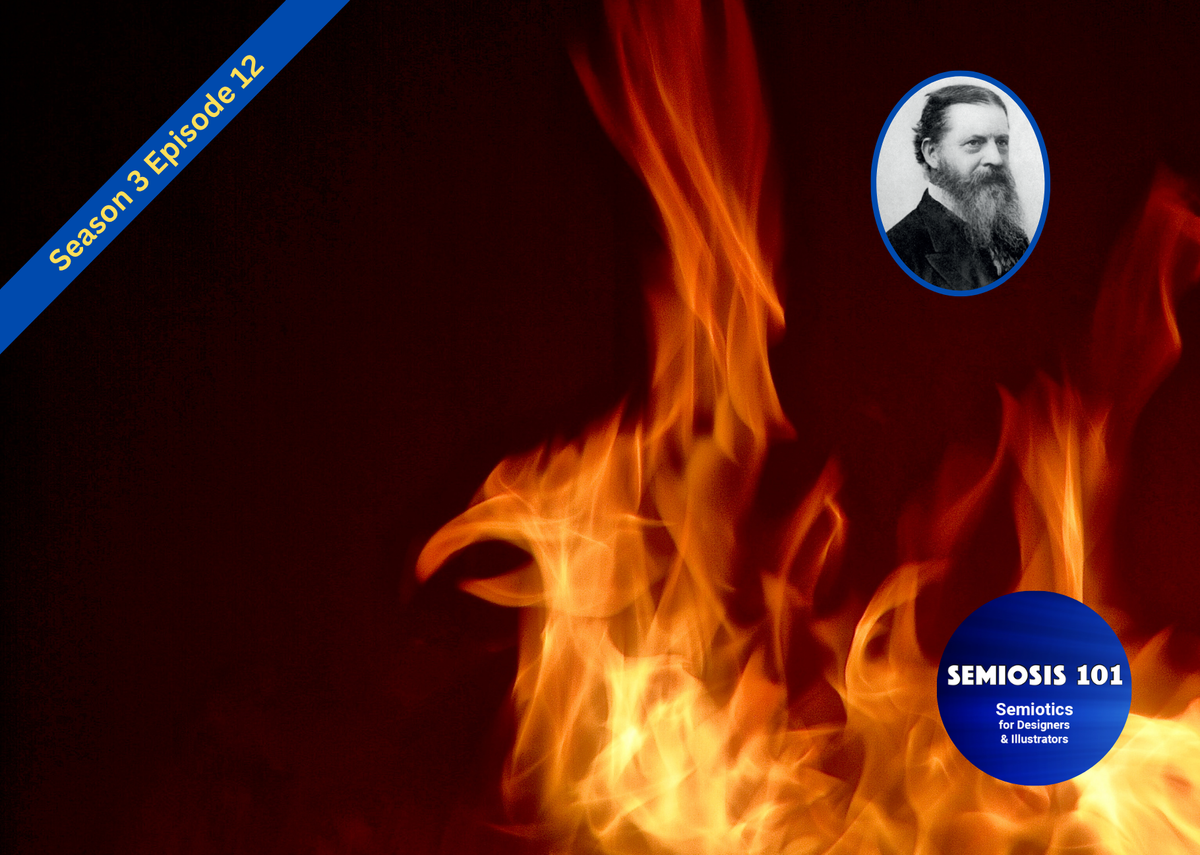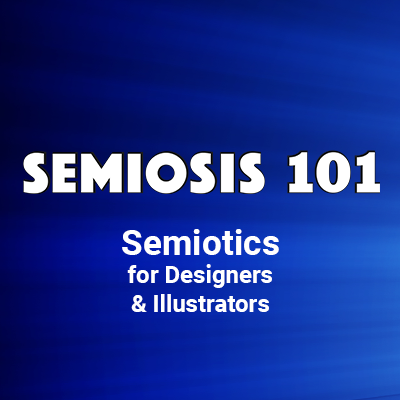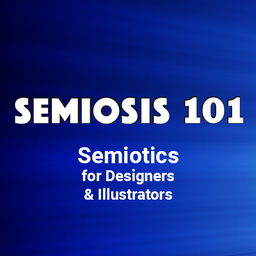Free Semiosis 101 Transcript 3.12:

LIKE A PHOENIX: The Probable Rising of Semiotic Sign-action
Hello readers.
In this free transcript for the episode published on Semiosis 101 on Weds 24 January 2024, we discuss in designer-centric language, whether the target audience can, based on their own lived experience and contextual knowledge, visually understand that one thing means something else …semiotically speaking.
Watch the free episode on YouTube for the full impact…
…and here is the episode’s transcript.
Last week we framed the conversation around semiotic encoding of meaning as a sign, as a possibility. What I mean by this is that there is a moment when something visual is meaningfully dormant, and then once perceived as a possibility of meaning-bearing, becomes interpretable. This means that all aspects of a creative’s visual communication skillset has the possible sign-action power to mean something else. Hit subscribe to this YouTube channel, and I will explain…
At the end of the last episode we where on a semiotic encoding cliffhanger. The discussion on the effects of interpretation of a semiotic sign on an interpreter, hung on what Scot’s describe as a shoogly peg, meaning a precarious situation. Interpretation of something that has been designed or illustrated either only being partly understood, or more meaning being interpreted to enrich further understanding.
The semiotic equivalent of a shoogly peg is whether on the strength of the creative’s representation decisions, the target audience can move from an immediate state to a dynamic state of interpretation. What this means in designer-centric language, is whether the target audience can, based on their own lived experience and contextual knowledge, visually understand that one thing means something else …semiotically speaking. Creatives’ cannot assume. That is why applying Semiosis helps.
“Wait a minute!” I hear some of you shout at the screen, “What, now?”
Retreading old ground here but if you draw a panda (concept) with the idea that just because, as a creative, you know what a panda looks like, everyone will see the panda (representation) and understand it is a drawing of a panda (interpretation), you will be congratulated for how well you draw pandas. But if not everyone knows what a panda is then they will never interpret what they see as a “panda.” In their lived experience and contextual knowledge, they do not have any experience of pandas.
Now substitute the concept of “panda” with whatever you need to visually communicate. So, how can creatives overcome this problem? Well, in season two’s episodes I explored semiotic representation and target audiences’ lived experiences. What we are really exploring here, in the context of semiotic encoding of meaning, and the successful interpretation of that meaning, is visually helping the audience to the intended meaning.
This semiotic facilitation of a target audience’s understanding of what they see, to enable the audience to extract as much intended meaning as they can from the visual communication, relies on what the audience is likely to interpret. The example I began to use last week was Semiosis 101’s parent Scouse-Scot brand’s visual identity. I used this logo to demonstrate this interpretive cliffhanger of either realising the two “birds” were just birds, or whether an audience could interpret Liver Birds from the representation.
This is the current Semiosis 101 interpretive shoogly peg. The moment between an immediate or dynamic effect on interpretation. What do I mean? Well, when you examine the Scouse-Scot logo, in its design, some of you out there will just see two bird shapes. Some of you will recognise they are Liver Birds. Some of you may not even see the shapes as birds. You will know which you are.
If you are the latter, then the semiotic encoded sign has not been perceived. The semiotic sign-action has not been triggered. The semiotic sign lies dormant. But the meaning-bearing visual entity is there in plain sight, but not perceived as something. If you are the former, the effect of the visual language used and the aesthetic decisions taken to visualise the two birds in the logo, is what Peirce refers to as an immediate effect on the interpretation. If you see “birds” the sign-action has begun.
If you see the two birds and recognise them as “Liver Birds” then the semiotic effect of its representation on you has moved from immediate to dynamic. You have been visually mediated to move from a possibility to a proposition, from possible “birds” to probable “Liver Birds.” The semiotic representation has had the effect on the interpreter who, in their lived experience, have knowledge and experience of the concept of Liver Birds can name them.
The Iconic visual communication building blocks of swirling red marks, composed into a certain pattern of these shapes suggests birds, then the shape of particular birds - Liver Birds. This triggering of more contextual meaning that enriches the understanding, is now at an Indexical level of representation. In Peircean terms, perception has moved from Firstness to Secondness, and from Rhematic to Dicent levels of interpretation. It has mediated interpretation into a proposal to those who know. The interpretation is now THIS thing.
Notice I stated this as “those who know”? Those who, in their lived experience, know of the Liver Birds of Liverpool can interpret the image at a deeper level of visually communicated meaning. Those have never heard of Liver Birds can still interpret some meaning of “two red birds” from the same image. One set of interpreters will have a deeper understanding of what they see than the other set of interpreters. Those who know, have been semiotically mediated to the Liver Bird interpretation.
In the image, that others only can interpret as “birds,” there are visually encoded Iconic marks, shapes and colours that reinforce the concept of “Liver Birds” rather than parrots, or eagles, or ostriches. So before we move on to conclude this episode, let us quickly summarise what this means to creatives.
One image…
An interpreter…
Aesthetic decisions…
Encoded semiotic signs…
Three possibilities for the semiotic sign-action effect of the representation (two birds) of the concept (Liver Birds), on the interpretation…
A) No perception of semiotic sign-action
B) A perception of two red bird shapes
C) A perception of two Liver Birds
The effect on the interpretation is dependent on the representation and interpretation. Upon the creative’s ability and the target audience’s lived experiences. Successful semiotic encoding is dependent on the HOW and WHAT contexts. How to select the appropriate visual language and make appropriate aesthetic decisions in designing or illustrating. What will the target audience understand from what is represented.
Semiosis helps the creative connect the HOW and WHAT into successful visual communications. Let us put this into clearer examples.
A) No perception of semiotic sign-action
Nothing in the visual entity is perceived as meaning-bearing. It is just perceived at face value. The audience cannot interpret two bird shapes amongst the lines, colours and shapes in the image. Why is this? If the creative’s visual language and aesthetic decisions are too stylised, any encoded semiotic sign-action may not be perceived. If the representation is also too realistic, any connotational meaning could be lost by a simple denotational interpretation. E.g. “This is a beautifully realistic drawing of cormorants.” (Liver Birds are purely fictional birds, just like a phoenix, but are thought to be based on cormorants). Any encoded Iconic representations to trigger familiarity of, and resemblances to qualities that are in the lived experience of the target audience have not been perceived as something.
B) A perception of two red bird shapes
The semiotic sign-action is triggered. The audience has enough lived experience to interpret the Iconic shapes as two red birds. The semiotic encoding in the creative’s visual language and aesthetic decisions, sufficiently visually communicate bird shapes. This means that the semiotic encoding has had an immediate interpretive effect on the interpreter, and put the concept of “birds” in the minds of the audience.
C) A perception of two Liver Birds
The interpretation of two red birds is a successful interpretation. But if the full concept to communicate is Liverpool (or Scouse), the image still has more meaning-bearing in the representation to interpret. While the semiotic sign-action has been triggered, the audience has more contextual knowledge within their lived experience to interpret further meaning from the image. From the Iconic two red bird shapes, the dynamic effect of ensuring the shapes put in the mind of the audience the concept of “Liver Birds” is mediated by how hard the shapes suggest one type of bird over another type.
Within semiotic encoding, the skill is to first understand what the audience may already know, what visual qualities can this knowledge suggest, and how can you as a creative, effectively use these Iconic building blocks.
I said in an earlier episode that this is not rocket science. Applying Semiosis is easier than you think once you align it to your existing creative practice. This is why Semiosis 101 is crucial. Peirce cannot be directly read as a creative “how-to” guide. Come back next week when we will explore how to dynamically mediate effective visual communication.
Semiosis 101 Semiotic Design Resources is a reader-supported publication. To receive exclusive posts and support my work, consider becoming a free or paid subscriber. Paid subscribers get name checked on all future Semiosis 101 YouTube episodes.
===Semiosis 101 Patreon Producer==============
Become a Semiosis 101 Patreon Producer and get a named producer credit on future video episodes, plus watch all new episodes months ahead of YouTube.
===Semiosis 101 Patreon Exclusives==============
Watch longer Patreon-exclusive Semiosis 101 episodes on applying Semiosis into design and illustration…
PATEXC001 How does semiotics work in illustration?





